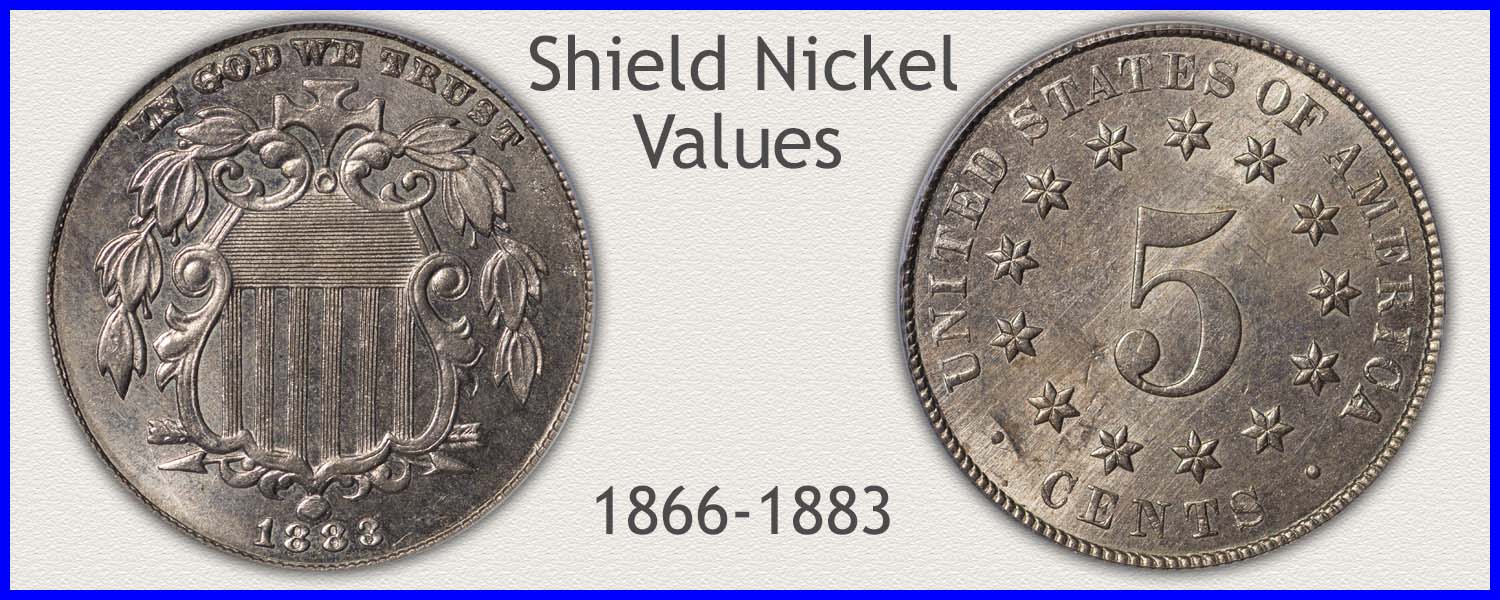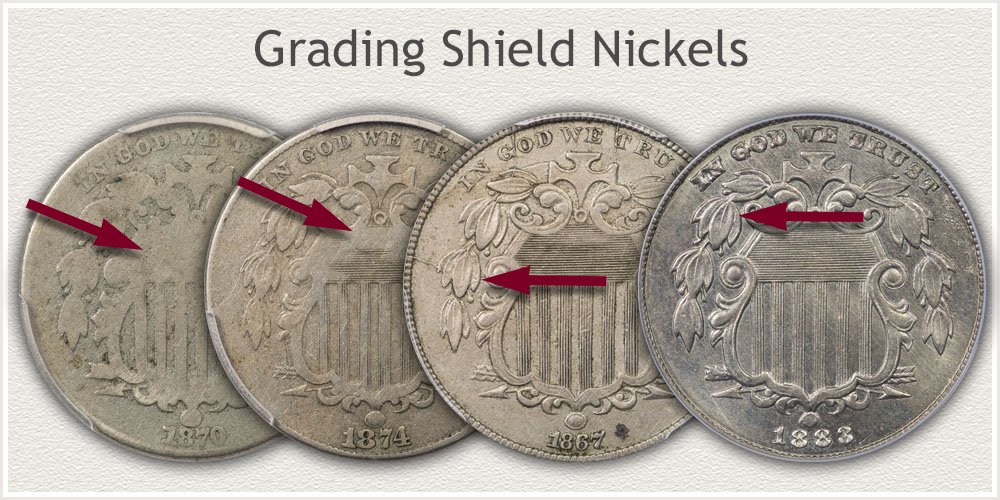Coin Values Moving with Precious Metals: Up-Dated 12/15/2025: Gold $4341 | Silver $63.26
1876 Nickel Value
A step-by-step process answers what the 1876 nickel value potential is. These early nickels are uncommon. Basis scarcity poses the greatest challenge to finding quality Shield nickels. Overall, Shield nickels rank midway in popularity among coin collectors. With demand holding value steady, eye appeal becomes a key factor in the market. Using the series of steps outlined below, your examination records an important description of the coin.
Use the magnified images, to match your coin with quality standards. This one step alone has a great influence on its potential in the coin market.
Notice the range, determined by condition, of how much an 1876 nickel is worth. A defined approach finds the qualities for an accurate reading of the listings.
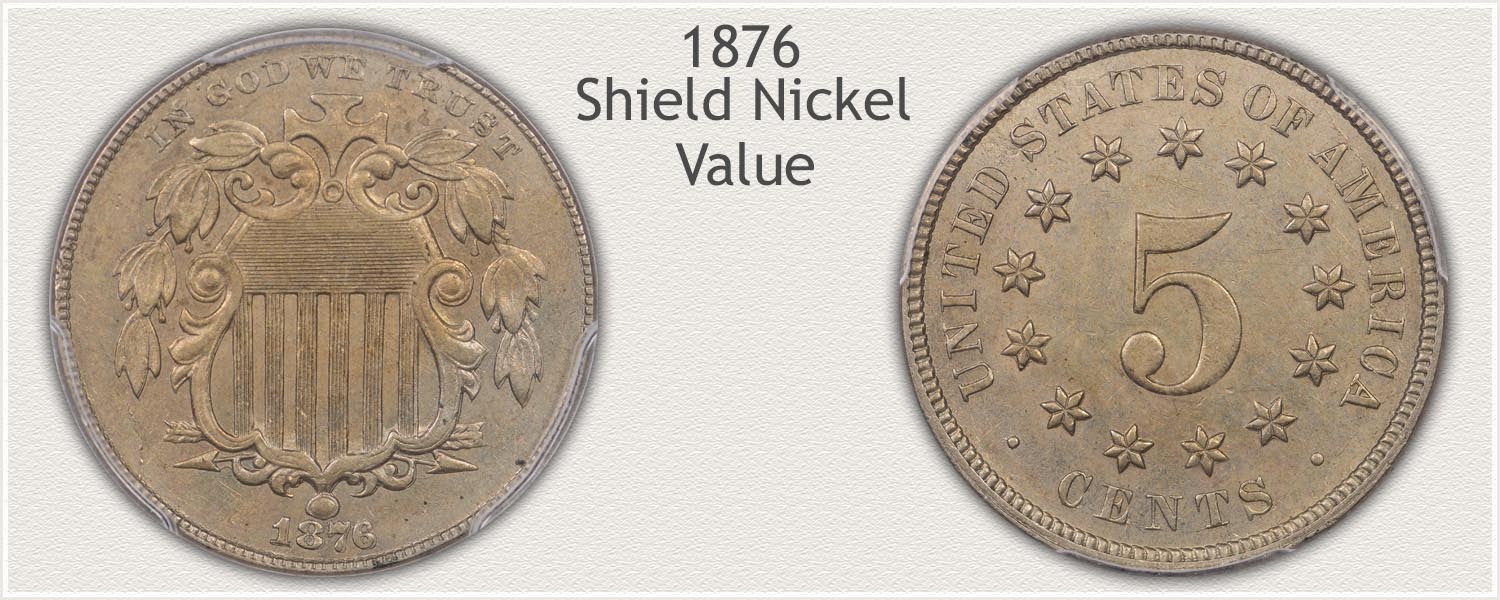
Steps Leading to Value:
- Step 1: Date Identified - A small size date becomes a big part of an accurate description of 1876 nickels. Confirm this key fact about the coin.
- Step 2: Grading Condition - Emphasis is placed on a coin's state of preservation. Determining a "Grade" of its condition becomes a deciding part of the evaluation.
- Step 3: Special Qualities - Shield nickels are very difficult to find displaying high quality features. Identify these subtle standout elements.
| 1876 Nickel Value | ||||
|---|---|---|---|---|
| Condition of Coin | ||||
| Date | Good | Fine | Extremely Fine |
Mint State |
| 1876 Nickel Value Updated | 2025 | |||
| 1876 | $34 | $83 | $104 | $208 |
Wholesale value chart for 1876 nickels. Listing a range these nickels trade in the market. Note, small changes in condition and preservation result in changes in premiums.
Step 1: Magnify the Date to Confirm an 1876 Nickel
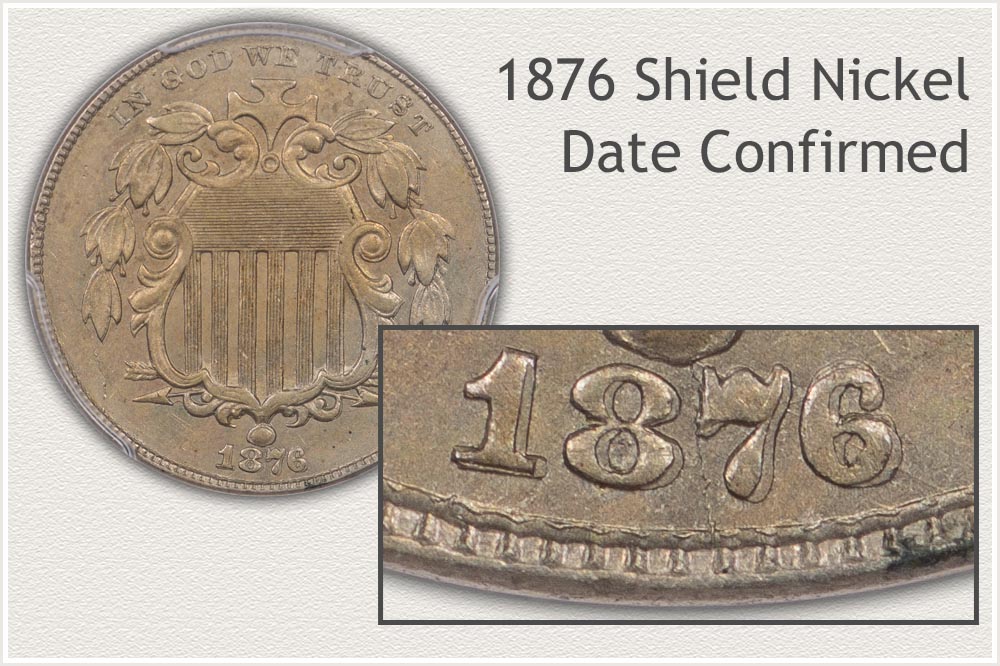
Every collector of Shield nickels carries a magnifying glass. With the small size of the date, and its vintage style, a close-up view identifies the correct date. Each date in the series has its own unique scarcity rating and value. Accuracy confirms the date first as part of a complete description of the coin.
1876 nickels enjoy strong premiums today. Most of its low mintage of 2.5 million pieces stayed in circulation for an extended period. Finding a high condition example is difficult today. Referencing the value chart, any example showing above average preservation is highly valued. There is strong demand for these scarce, quality examples.
Realizing the "6" of the date is often misread, magnify the date. Compare it to the illustration above. A close look helps identify and confirm this scarce date in the series.
Step 2: | Subtle Features are Highlighted to Judge Condition
Identify Above Average from Average Condition and Value
In the coin hobby, "Grading" defines the coin's condition into a term used as part of the description of a coin. Grades give collectors a quick assessment of what to expect about a coin's condition. As an example, a "Good Grade" nickel, quickly defines a heavily worn coin. Important to an 1876 nickel, is the premium value of lightly worn examples.
How to judge and then grade condition starts with finding a close match to the images. These images are professionally graded Shield nickels representing different levels of condition. Each grade requires specific features to remain distinct on the coin. As wear removes design elements, areas of flatness replace the design. Each stage rates a grade. Follow the descriptions and focus on the highlighted areas to confirm a grade.
Mint State Grade
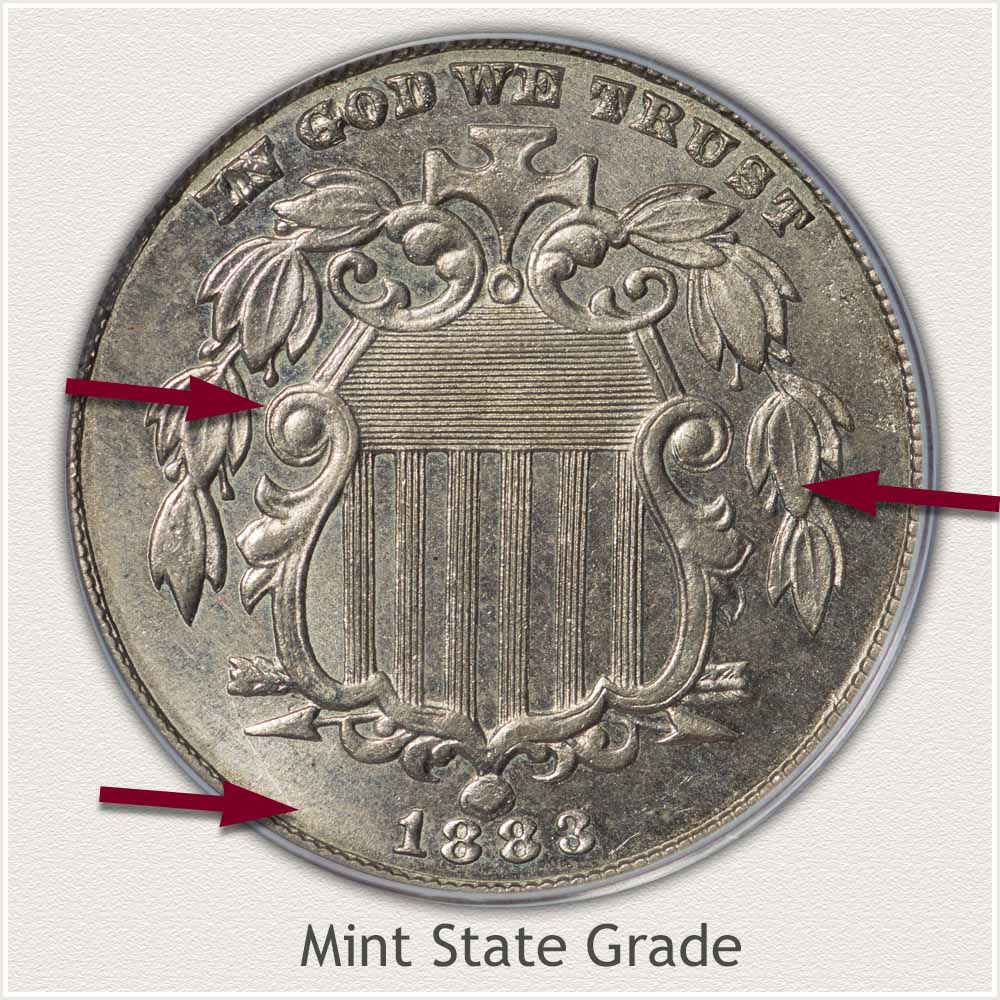
Mint State: A Mint State coin shows no evidence of circulation wear or handling on its surface. These coins retain their original texture and luster imparted during the minting process. Judge the grade by examining the design's high points for flattening or loss of detail.
An unworn coin exhibits a fine, texture and luster that radiates outward from the center. This delicate texture is the result of the minting process. It quickly wears and is lost once the coin enters circulation. When viewed under a single light source, intact texture creates a bright shine as light reflects off the coin's surface. The presence or absence of this original luster is a strong indicator if a coin is Mint State or a worn coin.
Helping identify an unworn surface. Examine the raised frame device surrounding the horizontal and vertical lines of the shield. High contours of the curved and rounded features remain covered in luster. Flattening, loss of detail, and loss of luster on the tops of these higher areas indicate a worn surface.
Compare the quality and luster of different areas of the coin. A consistent look remains across the entire surface. High contours of the frame match the look of lower recesses within the frame. The frame itself matches the brilliance and texture of the leaves on either side. Wear creates noticeable differences. Smooth areas, and dullness in color are traits of a worn surface.
When examining the coin under a single light, tilt the coin at various angles. Notice how the light reflects off the surface. Mint State coins display continuous luster, rotating across the surface. This light brightens both high and low areas. A worn coin loses luster intensity and when rotated, does not shine consistently.
Extremely Fine Grade
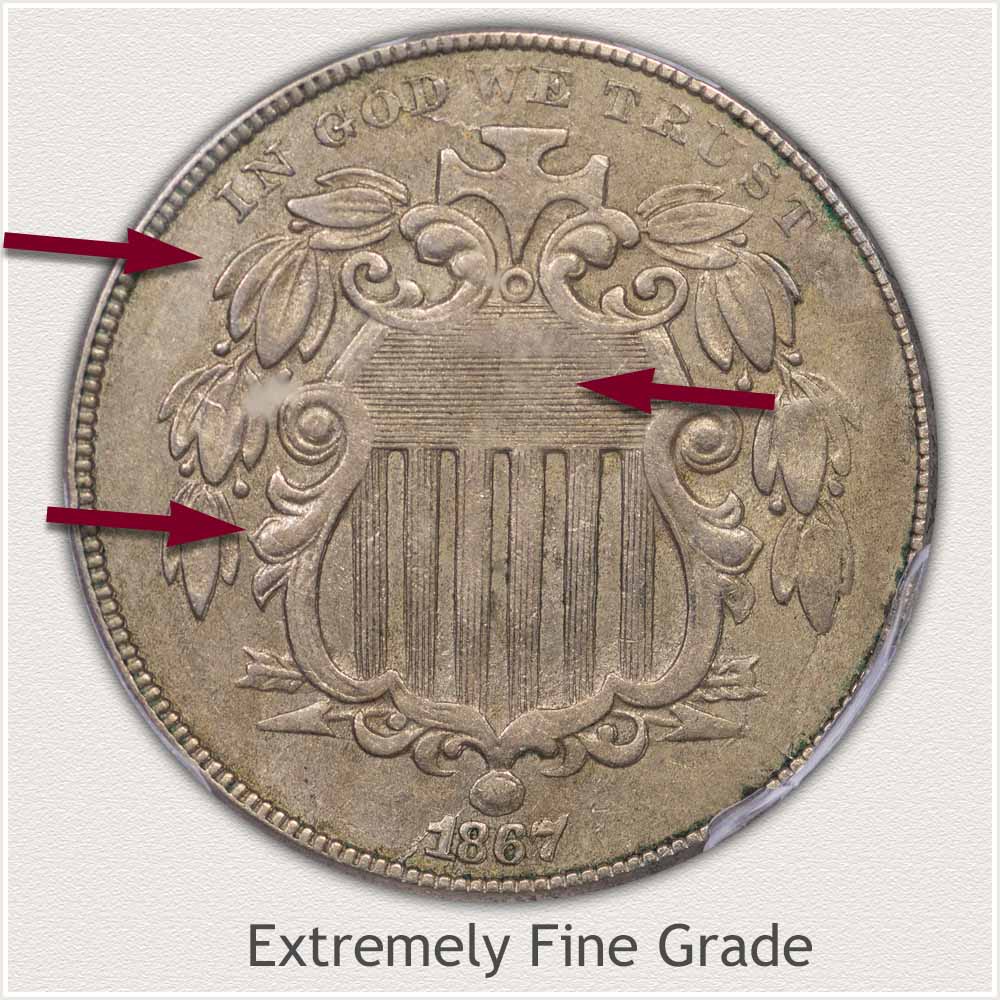
Extremely Fine: Shield nickels exhibiting only light wear define the Extremely Fine grade. On the highest points, sharp and crisp details remain. All original design elements are intact. Leaves within the branches and a detailed shield provide key areas to measure wear. First confirm, ample detail of the original design elements is intact. Small areas of flatness at the very high points meet the grade standard.
When examining a high-quality coin, start with the leaf elements. Two olive branches display leaf clusters with both high and low relief features. These areas provide easy to gauge levels of wear. Leaves remain well-defined, with only minor wear visible. The greatest wear smooths the tip of the topmost leaf of each group. Detailed veins, stems, and a low contour, within the leaves are bold and distinct.
Note in the example image, leaf clusters on the left side appear bold when compared to the right-side leaves. Variance in strike quality across the coin is a typical feature of these older nickels. Use the better side of your coin when determining the amount of wear.
Apply the metric of wear only on high points to the shield and its border. Central horizontal and vertical lines show slight smoothing with minor faded areas. An intricate border surrounding the lines features many high, curved contours. Each high point of the border shows small areas of flattened metal due to wear. The presence of deep recesses within the border indicates the wear is minor.
No major feature merging with another feature is a strict standard for the grade. Leaves show strong edges defining each leaf. Vertical lines are separate from horizontal lines and the frame. Inspect your coin for these distinctions. A strong similarity with the image narrows condition to the Extremely Fine grade.
Fine Grade
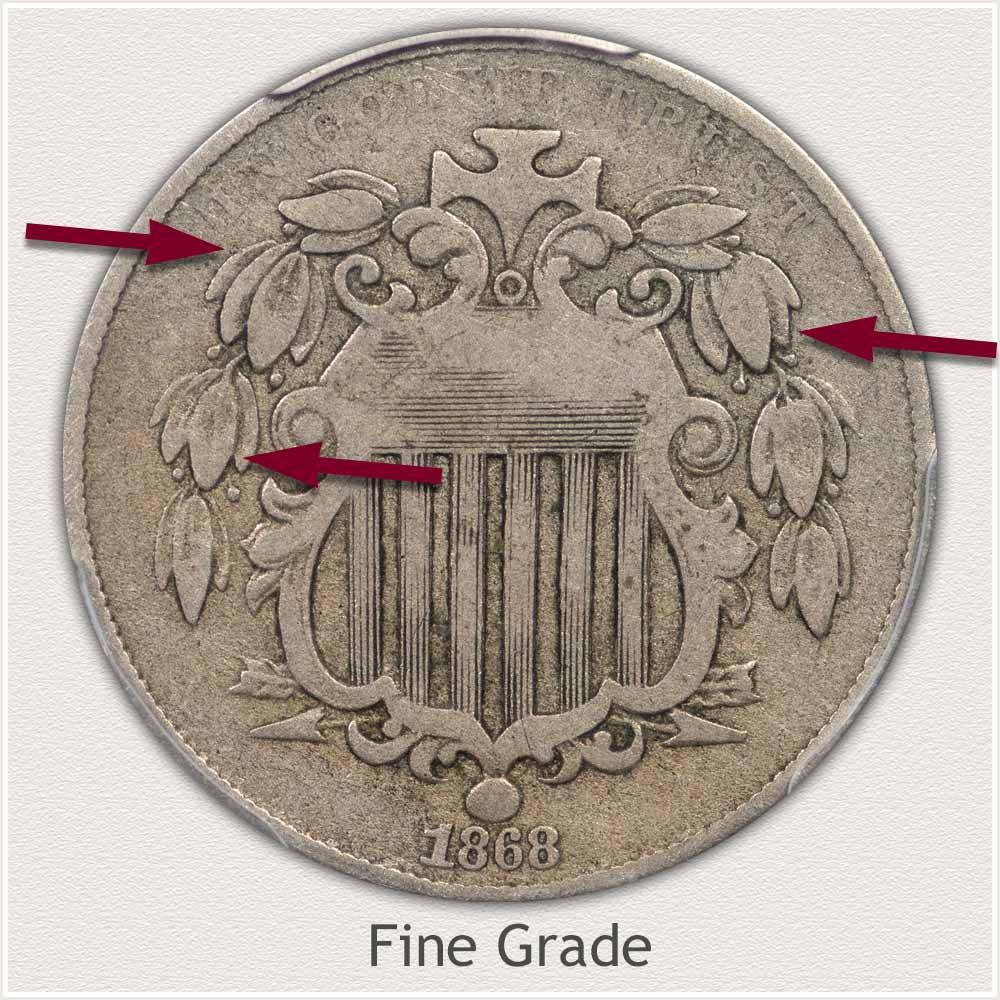
Fine Grade: A Fine grade Shield nickel displays moderate detail, with noticeable but balanced wear. Its general appearance shows the shield and olive branches clearly visible. All primary elements are distinct, with moderate circulation wear smoothing small areas. An inspection of key features measures specific wear amounts. Wear on the surface forms typical patterns, helping identifying the Fine grade.
First, inspect the leaves on the olive branches, particularly their edges. Most of the leaves display clear outlines. When examining the image, note the edges of the leaves, especially those on the left side, are very bold. Top most leaves are well separated from lower leaves. Judge the better side of your coin for an accurate reading of wear levels. Using this approach of grading the best side, accounts for weak strikes found on many nickels.
The amount of smoothness across the leaves also helps indicate the degree of wear. High points of the leaves, such as the tips and ridges, are the indicators. Flat areas begin at the tips of leaves and extend only half way over the leaf. Flattening is noticeable but does not dominate the surface of the coin. At the moderate wear level, many central veins and stems are visible within the leaves. Strong edges, partial smoothing of leaves and visual contours, determine the grade level.
Confirm the coin lacks large marks or nicks. Absence of visual distractions indicates a nice, collector quality Shield nickel.
Good Grade
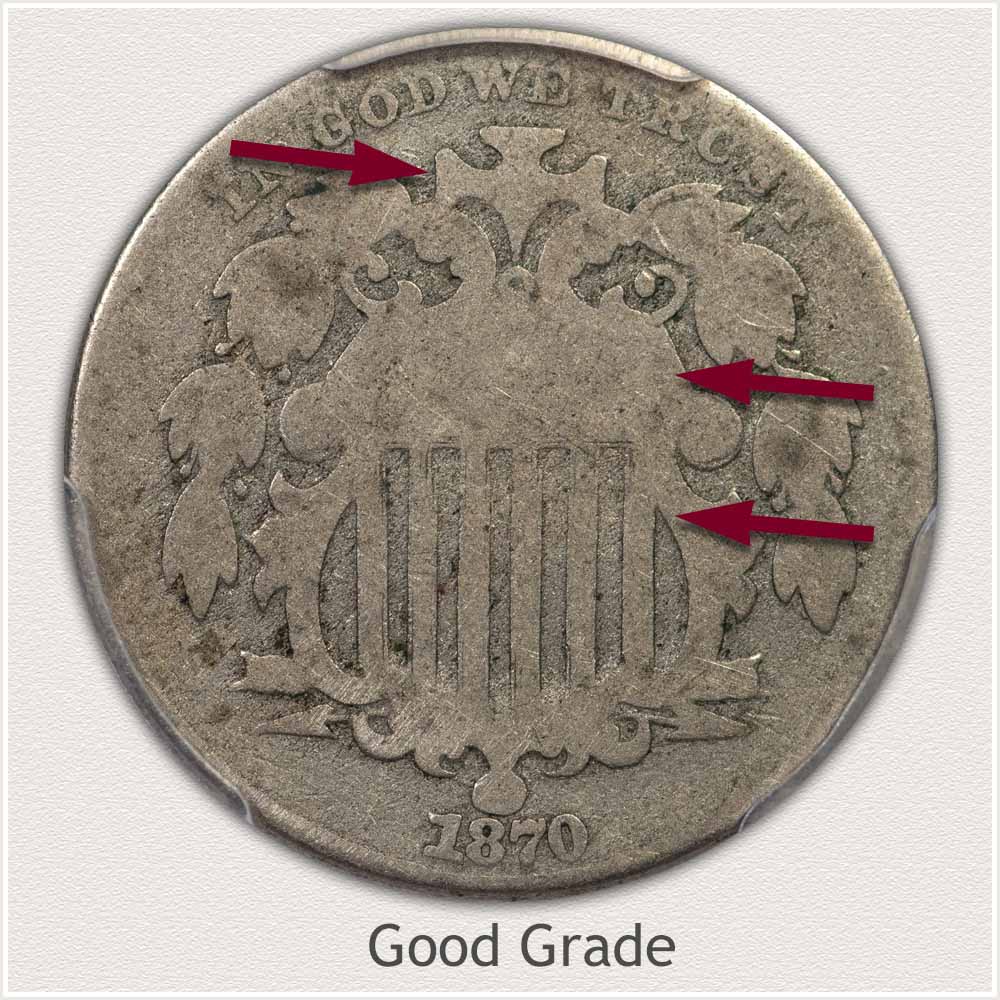
Good Grade: Inspecting the overall surface of the Shield Nickel, note the heavy wear covering the entire coin. Major designs appear smooth, and finer details are missing due to extensive circulation. However, despite the wear, key features remain visible. Judging these remaining details determines the coin's condition. Compare to the image as a reference of a coin in "Good" grade.
Examine the central shield design as the first focal point. All six vertical stripes remain distinct, bold, and slightly raised. The area above the stripes is smooth, connecting with the stripes and the shield's border. This flatness indicates heavy wear and a reliable indicator of the coin's condition.
Note the smoothness within the center area extends to the very edge of the shield's border. No fine detail or raised contours remain within the border. A defined outer edge is continuous around the shield meeting the grade standard. Without raised contours within the border, this flatness confirms the condition.
Next, confirm a bold cross outline at the top of the central shield. A full outline remains complete and visible as a raised area. This additional, subtle detail supports the coin's grade. Also, a visible motto above the shield measures the extent of wear. While some detail near the rim fades, the motto remains strong in the lower half of the lettering. A readable motto "In God We Trust" is a quality required to meet the grade.
Overall eye appeal presents well on the example coin. A bold date, full outlines on primary features, and a readable motto. A nice combination of visible design features despite flattened surfaces.
How to Video: Grading Shield Nickels
Step 3: | Special Qualities | Identify the Small but Premium Features
Subtle Features Indicate Above Average Quality
An enjoyable part of the coin hobby is finding a challenging coin to add to a collection. Shield nickels are a series with many subtle challenges for today's collector. Affordability is a significant factor as part of the hobby. Many dates within the series are rare and highly valuable, especially if in very high grades. Seeking lightly circulated coins is a typical strategy used by many.
Shield nickels without wear, the Mint State grade, are high premium coins. Often outside the collecting range. However, those with traces of circulation wear become affordable. The Extremely Fine grade is an ideal condition. These coins combine high quality, with many collectors able to participate.
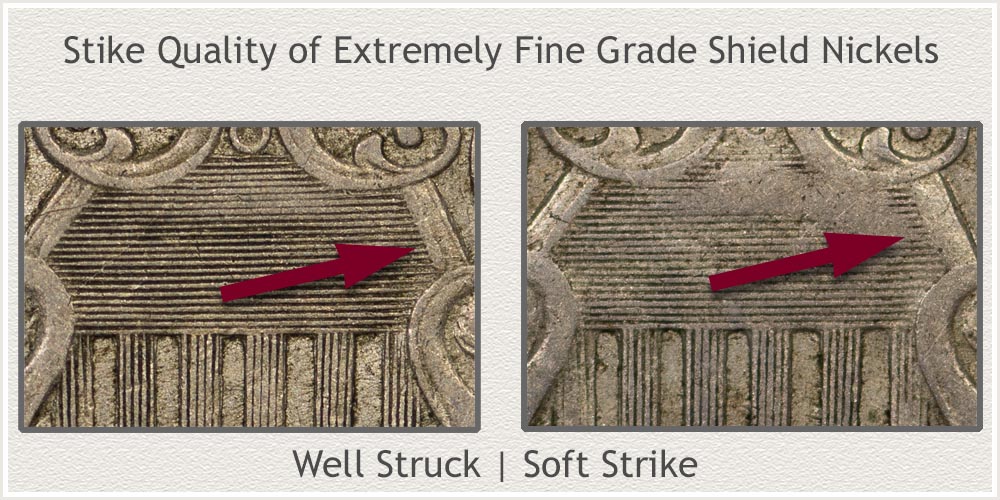 Different Strike Qualities of Shield Nickels Separate Premium Coins
Different Strike Qualities of Shield Nickels Separate Premium Coins
The challenge of seeking Shield nickels in Extremely Fine grade is the wide range of eye appeal. Technically, the amount of wear from one Extremely Fine grade coin to the next is very similar. Eye appeal becomes the important factor, with strike quality a big issue.
Difficulty in completely impressing the design on nickels was common. A well struck 1876 nickel is scarce when compared overall. A well struck example in Extremely Fine grade is the challenge.
One feature of intricate detail is the upper area of the shield. When viewing the example coins, focus on the horizontal lines. Note a visible difference where these lines meet the shield frame.
The first coin displays strong lines, and frame edges as two distinct elements. These frame elements are clearly separated by recessed lines. The second coin displays weakness as the lines meet the frame. The right-side frame is without any recessed lines dividing the frame. This missing detail is due to its soft strike quality. The left-hand coin is a premium, scarce, well struck example.
Other areas and features on Shield exhibit varying degrees of strike quality. Within the grade, using strike quality separates average from above average quality. The horizontal lines and shield frame are good indications used when judging.
With patience and viewing many examples, these special quality coins are eventually found and added to solid value collections.
References
U.S. Mint. Catalogue of Coins of the United States
https://nnp.wustl.edu/library/book/554591
U.S. Mint. 1888 U.S. Mint Annual Report
https://nnp.wustl.edu/library/book/313
Coin Values | CoinStudy Articles
Date by Date
In Depth Shield Nickel Value
Shield Nickel Value | Complete Value Chart of All Years
Complete value chart listing of Shield Nickels. Note how much an 1876 is worth in high condition compared to other dates. The important step of judging condition is further illustrated with large grading images. This approach provides a step-by-step method to an accurate reading the chart.
How to Grade Shield Nickels | Visual Guide
Judging the condition of an 1876 Shield nickel narrows the large differences in value. A range of grades are presented in the visual guide, indicating features to examine. Subtle details are highlighted for specific requirements to meet the various grades. With images to illustrate important points, arrive at a conservative judgment of condition.
Coin Grading Services | Premium Coins Benefit When Graded to Industry Standards
High value, $100 and above, coins enjoy market acceptance when professionally evaluated. The two leading coin grading services, authenticate, grade, and encapsulate the majority of the collectible coins in today's market. Review their services as part of evaluating any scarce coin.
Selling Coins | Organized and Planned
Use the proven methods followed by collectors when selling coins. Steps organize your coins, establish a grade range and value. Review the listing of auctions, coin conventions, and dealers. Find the best market to handle the collection.
Safe Coin Storage | Recommendations
Properly storing coins long term avoids unnecessary damage. Supplies designed specifically for the coin hobby protect coins and organize a collection. Today, modern, inert plastic holders house individual to many coins. A few basic supplies safely protect coins from damage and limit environmental exposure.
Popular Coin Series | Potential of Shield Nickels
High premiums move towards the popular coin series collected. The different series of coins show in charts ranked in order of popularity. Gaining insight into demand and popularity, helps recognize scarce coins with solid value. Overall, the charts illustrate forming collections of nickels is moderately popular. Interest in Shield nickels is a series with high up-side potential.
★Coin Values Discovery finds 1876 Nickel Value and...
Old U.S. coin values. Use the step-by-step method outlined to evaluate and determine how much a box of old coins is worth. An emphasis on accuracy of the date, variety, and condition of the coin narrows its value range on the charts.
